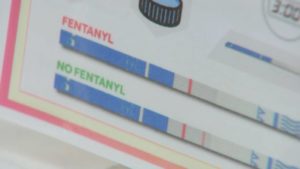Initially the crisis was sparked by over-prescribing. In the 1990s, new long-acting opioid medications such as extended-release oxycodone and transdermal fentanyl became available and accepted by doctors and patients for treating pain. Doctors became more comfortable prescribing these medications and pharmacies began to stock more of them. When public health prevention measures such as the Prescription Drug Monitoring Program were implemented and healthcare providers changed prescribing practices making opioid-based medications harder to get, many people turned from prescription opioids to heroin.
In the latest phase of this crisis, drug suppliers are mixing heroin and other drugs such as methamphetamine, cocaine, and counterfeit pills with more powerful synthetic opioids, such as illegal fentanyl. Accidental overdose can happen to anyone taking drugs, even if occasionally or for the first time. For those using cocaine, methamphetamine, or heroin, overdose risk is greater, due to the rise in frequency of fentanyl-laced drugs. Yet even those not involved with illicit opioids could be at risk. As reported by the Union Leader, Northeast Regional Director for American Medical Response (AMR) Chris Stawasz noted that “ first responders are seeing an increase in the presence of fentanyl in drugs seemingly unrelated to opioids, such as cocaine. Many who are saved from overdoses are in disbelief that they had an overdose.” You should never take prescription medication that isn’t prescribed to you, and provided to you by trusted professionals, such as pharmacists. Some prescription medications like Xanax, Oxycodone, and Adderall have been found to be mixed with fentanyl.
It takes very little to produce a high with fentanyl, making it a cheaper option and more profitable for the suppliers. Pharmaceutical fentanyl is 50 to 100 times more potent than morphine*. You should assume that any pill or drug not purchased directly from a pharmacy could contain fentanyl. You should also be aware that when not made in a regulated lab by technicians and pharmacists, each batch is different in potency or contents. It is especially important to educate young people about these new, hidden risks in substances they may view as harmless or low-risk.
Resources
 The Partnership @drugfreeNH (The Partnership) recognizes the value and importance of knowing the facts about fentanyl. We have developed two, mini-social toolkits for partners to use on Strategies to Avoid Opioid Misuse, Preventing Accidental Overdose, and Essential Tools for Fentanyl-Related Opioid Overdose Prevention. The toolkit includes sample messages and images and features three factsheets to support the prevention community’s efforts in addressing the opioid crisis in New Hampshire. The factsheets share essential information and strategies on how to engage your community and young people on the importance of avoiding opioid misuse, means of preventing accidental overdoses, and where to find fentanyl test strips and naloxone (Narcan™). You can find the toolkit and all three factsheets at https://bit.ly/OpToolkit.
The Partnership @drugfreeNH (The Partnership) recognizes the value and importance of knowing the facts about fentanyl. We have developed two, mini-social toolkits for partners to use on Strategies to Avoid Opioid Misuse, Preventing Accidental Overdose, and Essential Tools for Fentanyl-Related Opioid Overdose Prevention. The toolkit includes sample messages and images and features three factsheets to support the prevention community’s efforts in addressing the opioid crisis in New Hampshire. The factsheets share essential information and strategies on how to engage your community and young people on the importance of avoiding opioid misuse, means of preventing accidental overdoses, and where to find fentanyl test strips and naloxone (Narcan™). You can find the toolkit and all three factsheets at https://bit.ly/OpToolkit.
Harm Reduction
Some people who are dependent on substances may not be ready or want to stop using drugs. In this instance, it is practical to use methods that reduce the harm they may experience. Syringe exchanges, Fentanyl test kits and Narcan/naloxone, and overdose reversal medication are examples of Harm Reduction tactics.
Effective Messaging
Stigmatizing language assigns negative labels, stereotypes, and judgment to certain groups of people. Such language can contribute to negative outcomes such as social isolation, reduced self-esteem, and less likelihood to seek medical help.
Stigma acts as a barrier to treatment and has clear impacts: it prevents people who meet the criteria for a SUD from seeking and accessing the treatment they need. The first step to better supporting people with a SUD is changing our language**.
Language can reflect subconscious biases and it can help or harm people with stigmatized conditions, including substance use disorder. Eliminating stigmatizing language is a core component of the National Movement to End Addiction Stigma. Stigmatizing language can perpetuate isolation and misunderstanding between people with substance use disorder (SUD) and their communities. Terms like “drunk”, “addict” and “junkie” imply an affected individual causes their own illness and can lead to less sympathetic responses (e.g. incarceration instead of treatment).
Person-first language places emphasis on people rather than their diagnosis or condition (e.g. “person with a substance use disorder” vs. “addict”). This type of language can shift the way people with substance use disorders are viewed. By utilizing person-first language, an individual is no longer defined by their condition. The person is placed first with the condition being secondary, which helps to eliminate stereotypes and biases.
*Centers for Disease Control and Prevention, National Center for Injury Prevention and Control, June 1, 2022.
**National Movement to End Addiction Stigma, Addiction Language Guide. February, 2021.

